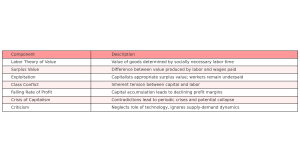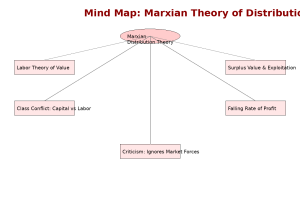
24 Jul Marxian Theory of Distribution
Marxian Theory of Distribution – UPSC Economics Optional Notes
Introduction
The Marxian theory of distribution, formulated by German philosopher and economist Karl Marx, is a fundamental critique of capitalist systems. Unlike classical economists who emphasized marginal productivity and market dynamics, Marx focused on class struggle, surplus value, and exploitation as core principles driving income distribution. His theory is not just an economic framework, but a socio-political analysis of capitalism. Understanding this theory is crucial for UPSC aspirants preparing for Paper 1 of the Economics optional syllabus.
1. Foundations of Marxian Theory
The Marxian theory of distribution rests on three major pillars:
- Labor Theory of Value: Value is determined by the amount of socially necessary labor time required to produce a commodity.
- Surplus Value: The difference between the value created by labor and the wages paid to workers. This surplus is appropriated by capitalists.
- Class Conflict: Society is divided into two primary classes — capitalists (owners of production) and workers (sellers of labor). Their interests are inherently opposed.
2. Surplus Value and Exploitation
In a capitalist system:
- Workers sell their labor power for a wage.
- However, the value they produce in a workday exceeds the wage they are paid.
- This excess value is the surplus value, which the capitalist keeps as profit.
Marx termed this difference between value produced and wages paid as exploitation of labor.
3. Wage Determination
According to Marx:
- Wages are determined not by productivity, but by the cost of reproducing labor — i.e., the cost of food, shelter, clothing, and sustenance.
- Capitalists aim to keep wages at subsistence level to maximize surplus value.
- Wage increases are often temporary and limited by the reserve army of unemployed laborers.
4. Profit and Capital Accumulation
Profits arise from the unpaid portion of labor. These profits are reinvested into capital, leading to:
- Technological advancement and increased productivity
- Greater exploitation through intensification of work
- Increased concentration of wealth in the hands of a few
Marx warned that this cycle would eventually lead to internal contradictions and crises.
5. Falling Rate of Profit
As capitalists invest more in machinery (constant capital) and less in labor (variable capital):
- Surplus value generated (from labor) begins to fall
- This causes the rate of profit to decline over time
- The system becomes unstable, leading to crises like overproduction, unemployment, and inequality
This dynamic is known as the Law of the Tendency of the Rate of Profit to Fall.
6. Class Conflict and Revolution
Marx believed that the fundamental contradiction between capital and labor would intensify. The working class would eventually:
- Recognize their exploitation (class consciousness)
- Organize and revolt against the capitalist system
- Establish a classless, socialist society
Thus, income distribution under capitalism is not merely economic but rooted in class struggle.
7. Criticisms of Marxian Theory
- Neglects role of demand and consumer choice
- Assumes labor as the only source of value
- Underestimates technological progress and capitalist innovation
- Fails to account for rising wages in advanced economies
- Revolution predictions have largely not materialized
Despite criticisms, Marx’s focus on inequality, power imbalance, and class dynamics remains relevant in contemporary debates.
8. Infographic

Marxian_Distribution_Theory_Infographic
9. Mind Map

Marxian Distribution Theory MindMap
10. Relevance in Today’s Economy
- Explains rising inequality and worker exploitation in gig economies
- Helpful in understanding anti-globalization and labor movements
- Applied in critiques of neo-liberal capitalism and monopoly power
Marxian analysis is still used in heterodox economics, sociology, and political economy.
11. Previous Year Questions (UPSC Economics Optional)
- UPSC 2022: Discuss the Marxian concept of surplus value and its relevance in modern economies.
- UPSC 2020: Compare and contrast Ricardian and Marxian theories of income distribution.
- UPSC 2016: Explain the concept of exploitation as per Marxian economic theory.
12. Probable UPSC Questions
- Mains: “Evaluate the Marxian theory of distribution in the context of growing automation and AI.”
- Mains: “Discuss the role of class conflict in Marxian theory and its modern-day relevance.”
- Prelims: “Which of the following is central to the Marxian theory of exploitation?”
- Prelims: “According to Marx, profit is derived from…”
13. Conclusion
The Marxian theory of distribution provides a critical lens through which income distribution, class dynamics, and capitalist contradictions can be analyzed. While some assumptions may be outdated, the core insights into exploitation and inequality remain valid. For UPSC aspirants, mastering this theory is essential for writing informed, analytical answers in the Economics optional paper.
best economics optional test series




No Comments